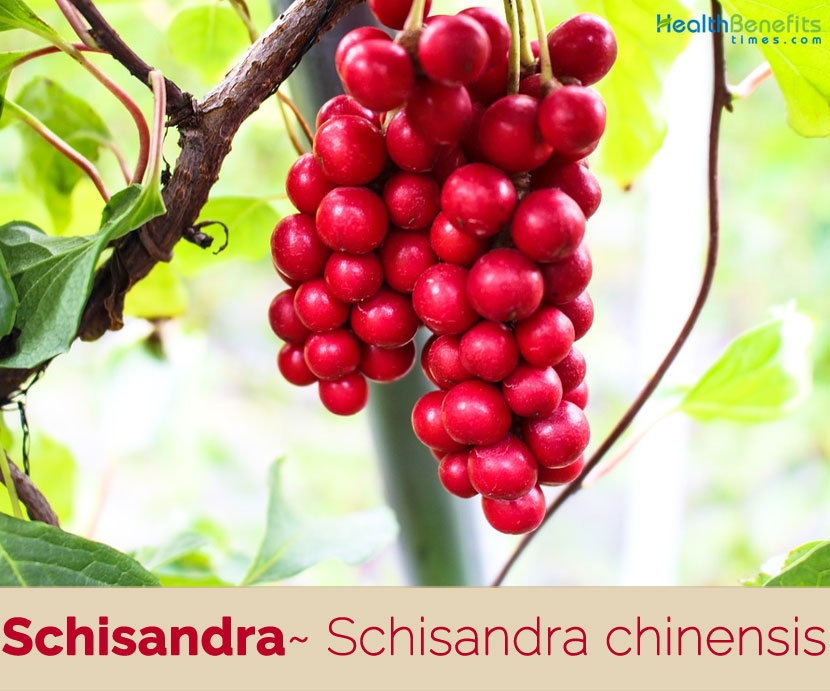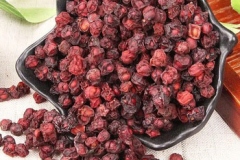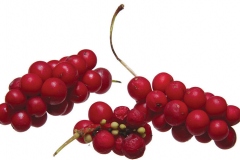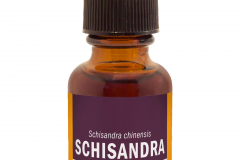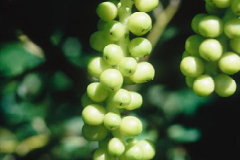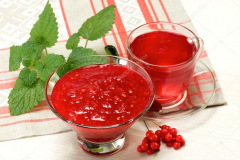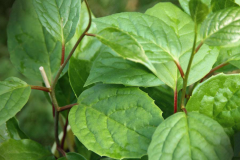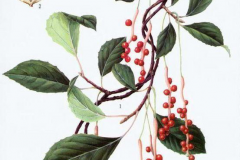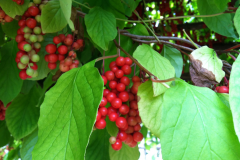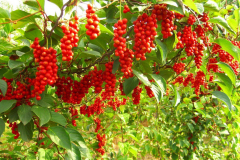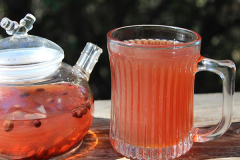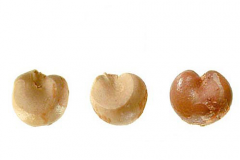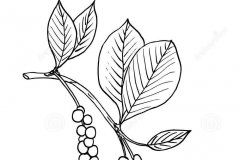| Schisandra Quick Facts | |
|---|---|
| Name: | Schisandra |
| Scientific Name: | Schisandra chinensis |
| Origin | Forests of Northern China and the Russian Far East |
| Colors | Strong red color |
| Shapes | Berries, about 1 cm in diameter, whose exocarp and mesocarp are smooth, shiny |
| Taste | Salty, sweet, sour, pungent, bitter |
| Health benefits | Alzheimer’s disease, Cures Depression, Liver Function, Lung Health, Promotes smooth and flawless skin, Promote Mental Performance, Fights Fatigue, Menopause, Helps Improve Mood & Sleep, Anti-stress and Stress Management, Heart Health, Sexual Performance, Physical Performance, Anxiety and Insomnia, Skin Health |
| Name | Schisandra |
|---|---|
| Scientific Name | Schisandra chinensis |
| Native | Forests of Northern China and the Russian Far East (Amur region, Sakhalin) |
| Common Names | Chinese magnolia vine, Five-flavor-fruit, Magnolia vine, Schisandra, Schizandra, Schizandra berry, lemon wood, herb of five tastes, Wu wei zi, Five flavor berry, Gomishi, Omicha, Omija, Ngu mie gee |
| Name in Other Languages | Arabic: Shazandrat sinia (شزندرة صينية) Armenian: Shizandra ch’inakan (շիզանդրա չինական) Azerbaijani: Çin cır limonu Belarusian: Limonnik kitajskij (лімоннік кітайскі) Bulgarian: Kitaĭska shizandra (китайска шизандра) Chinese: Wu wei zi (五味子), Wu Wei ZIn Croatian: Šisandra Czech: Klanopraška čínská Danish: Schisandra Dutch: Chinese schisandra, Schisandra bes, schisandra English: Chinese magnolia vine, Five-flavour-fruit, Magnolia vine, Schisandra, Schizandra, Schizandra berry, lemon wood Estonian: Hiina sidrunväändik German: Chinesisches Spaltkölbchen, Schisandra bær Hungarian: Kínai kúszómagnólia Finnish: Palsamiköynnös French: Schisandra de Chine Japanese: Chosen-gomishi (チョウセンゴミシ), Hure-hat, repnihat-punkar Korean: Omija (오미자), Omidza Latvian: Citronliāna Lithuanian: Kininis citrinvytis Polish: Cytryniec chiński Russian: Limonnik kitajskij (Лимонник китайский) Slovenian: Šisandra Swedish: Fjärilsranka Ukrainian: Lymonnyk kytaysʹkyy (лимонник китайський) Vietnamese: Ngũ vị tử bắc |
| Plant Growth Habit | Aromatic, deciduous, climbing woody vine |
| Growing Climates | Mixed forests, especially on the margins, also by streams and brooks, usually on sandy soils |
| Soil | Prefers a slightly acid soil but tolerates some alkalinity if plenty of organic matter is added to the soil |
| Plant Size | 20 to 30 ft. high |
| Branchlets | Red, round, not downy, set with wart-like lenticels |
| Leaf | Leaf blade elliptic to obovate, 4.5-8(-10.5) × 2.5-6.5 cm, thinly papery to papery, not glaucous, venation glabrous or rarely adaxially sparsely pubescent, |
| Flowering season | April to May |
| Flower | Flowers are unisex, usually dioecious than monoecious, solitary or in clustering axillae with 6-9 milky white or pink tepals |
| Fruit Shape & Size | Berries, about 1 cm in diameter, whose exocarp and mesocarp are smooth, shiny |
| Fruit Color | Strong red color |
| Propagation | From seed, cuttings or by layering |
| Plant Parts Used | Seed, fruit |
| Seed | 1–2 kidney-shaped seeds inside each berry |
| Taste | Salty, sweet, sour, pungent, bitter |
| Available Forms | Dried powder, pills, extracts, and elixirs |
| Season | Late August and early September |
| Health Benefits |
|
| Other Facts |
|
Plant Description
Schisandra also referred to as Schizandra or Schisandra Chinensis is an aromatic, deciduous, climbing woody vine that normally grows about 20 to 30 ft. tall. The plant is found growing in mixed forests, especially on the margins, also by streams and brooks, usually on sandy soils. The plant prefers a slightly acid soil but tolerates some alkalinity if plenty of organic matter is added to the soil. Branchlets are red, round, not downy, set with wart-like lenticels. Petiole is 0.9-4 cm long and glabrous. Leaf blade is elliptic to obovate, 4.5-10.5 cm long and 2.5-6.5 cm wide, thinly papery to papery, not glaucous, venation glabrous or rarely adaxially sparsely pubescent. Secondary veins are 3-6 on each side of mid vein, base cuneate, attenuate, or rarely broadly cuneate. The leaf margins is grandular serrulate and no hair on the surface.
Flowers
The flowers are unisex, usually dioecious than monoecious, solitary or in clustering axillae with 6-9 milky white or pink tepals. There are 5 stamens and anthers cluster on the top of cylindrical receptacle. The female flower has 17-40 carpels and the receptacles prolong after flowering. Flowering normally takes place from April to May.
Fruit
The species itself is dioecious, thus flowers on a female plant will only produce fruit when fertilized with pollen from a male plant. Fertile flowers are followed by small berries, about 1 cm in diameter, whose exocarp and mesocarp are smooth, shiny, of a strong red color. The berries are clustered in grape-like bunches about 10 cm long
This healthy and exotic berry is categorized as an adaptogen, meaning it helps prevent physical and chemical stress on the body. When consumed, it gathers in the heart, brain, kidneys, lungs, and liver tissues.
Health benefits of Schisandra
Schisandra can be used for a wide range of health-related issues. There’s certain scientific data from animal and human research that specify Schisandra may have a positive effect on several conditions and diseases. Listed below are some of the popular health benefits of Schisandra
1. Alzheimer’s disease
Research has discovered that Schisandrin B had a beneficial, positive effect on Alzheimer’s disease. Researchers determined that this was caused by Schisandrin B’s ability to block formation of excess amyloid beta peptides in the brain. These peptides are one of the components responsible for forming amyloid plaque, a substance found in the brains of people with Alzheimer’s disease.(1)
Another research indicates that Schisandrin B may be effective against both Alzheimer’s and Parkinson’s disease. This is due to its anti-inflammatory, neuro protective effect upon microglial cells in the brain. (2)
2. Cures Depression
Animal research found that Schisandra extract had an antidepressant effect on mice. Additional research, run by the same lead researcher, solidified this finding. However, Schisandra and its potential effect on depression haven’t been extensively studied in humans.(3),(4)
3. Liver Function
Schisandra has been used traditionally to treat liver diseases such as hepatitis and improve liver function. Schisandra antioxidants are mostly responsible for these effects. They help maintain liver function while preventing damage. (5)
In Japanese herbal medicine, a mixture of herbal extracts TJ-108 is used to treat hepatitis C. Schisandra extract seems to be the key ingredient in this mixture (6).
In a research scientists detected the potential of schisandra extract and schisandrin B to improve non-alcoholic fatty liver disease (NAFLD) and alcohol-induced liver damage. (7), (8), (9)
4. Lung Health
Supplements that consist of Schisandra extract are traditionally used to treat a cough and asthma.
In 60 pneumonia patients, a product containing rhodiola, schisandra, and Siberian ginseng reduced the duration of antibiotic treatment and improved quality of life, compared to standard treatment alone.(10)
5. Treats Menopause
Research carries out with Schisandra extract on women with menopausal symptoms shows positive response. Researchers determined that Schisandra is effective at alleviating some symptoms of menopause. These symptoms included hot flashes, sweating, and heart palpitations.(11)
6. Physical Performance
Schisandra increases nitric oxide levels in athletes, possibly improving their performance.(12)
Schisandra improved exercise performance and endurance by helping the animals adjust to stress.(13), (14)
7. Anxiety and Insomnia
Schisandra helps to reduce corticosterone (animal version of cortisol), the stress hormone, in rats.(15)
Small dosage of Schisandra promoted calmness and relaxation and improved sleep quality.(16)
Research also concluded that schisandra may help control the changes in adrenaline and serotonin levels caused by stress, combat “adrenal fatigue” linked to stress, and reduce anxiety.(17), (18)
8. Heart Health
Schisandra helps to increase blood flow and nitric oxide availability in two smaller clinical trials, which might safeguard the heart and blood vessels in theory.(19), (20)
However, no clinical studies have investigated the effects of Schisandra on heart health. Sheng-Mai-San, a supplement that contains Schisandra fruit extract, is used to treat heart disease in Chinese traditional medicine.(21)
9. Skin Health
Schisandra berry was valued by Chinese for its beauty and anti-aging qualities. Packed with antioxidants, including key vitamins C and E, Schisandra’s strong astringent qualities enable the skin to hold in moisture for more fullness. Schisandra may also protect against UVB induced skin damage and is still used as an important botanical in many Eastern skin formulas.
10. Sexual Performance
Schisandra is known to boost water Qi in the kidney and to support water of the genital organs- referring to the sexual fluids. For men, the sexual fluids promote the production of semen. For the ladies, Schisandra is said to increase circulation and sensitivity in the female genitals. This feeling will increase orgasms and satisfaction. This makes Schisandra a very powerful aphrodisiac that can compliment intimate relationships.
11. Anti-stress and Stress Management
Traditionally, schisandra have been used for stress management, mostly because this class of herbs shows positive health effects on the adrenal system. The adrenal glands are responsible for the production of stress hormones and stress-response mediators like cortisol. By squelching excessive production and secretion of molecular chaperones, cortisol and nitric oxide, schisandra aids in stabilizing the levels of these stress-associated compounds in the blood. In turn, this keeps the negative effects of stress (i.e., fatigue, mental fogginess, low energy levels etc.) at bay.
12. Fights Fatigue
Schisandra has the ability to fight fatigue both mental and physical. It has the ability to reduce the harmful effects of the stress response (i.e., weakness and lethargy) in turn helps to endorse mental clarity. This is yet another reason why endurance athletes have historically used schisandra supplementation for performance enhancement.
13. Helps Improve Mood & Sleep
Schisandra helps to curb feelings of anxiousness and even improve mood. Schisandra’s positive effects on the brain have also concerned this powerful herb in the therapeutic prevention of a variety of psychological and neurological disorders, including depression and anxiety. The calming effects of schisandra can enhance sleep quality. In fact, in some cases it has been used as a sleep aid for those who suffer from sleep disorders.
14. Promotes smooth and flawless skin
Schisandra’s in anti-inflammatory effects help the body to hinder inflammatory processes such as those involved in the development of dermatitis and a variety of other inflammatory skin conditions. Schisandra’s positive role in overall tissue repair also shines when it comes to the outer layers themselves. So, when push comes to shove, wave inflammation goodbye and welcome schisandra for salvaging your skin!
15. Promote Mental Performance
Improving mental clarity and performance is one of the oldest uses of schisandra. It has been used for centuries in Russia to promote stamina and in traditional Chinese medicine to improve concentration, memory, motivation, and mental health. Caffeine can cause restlessness, nervousness, and an irregular heartbeat. Schisandra on the other hand has the opposite effect of caffeine, and it can make you feel calmer while fighting fatigue. Research has suggested that schisandra fruit extract may be useful in the prevention and treatment of Alzheimer’s disease.
Traditional uses and benefits of Schisandra
- Schisandra is commonly used in Chinese herbalism, where it is considered to be one of the 50 fundamental herbs.
- It is an excellent tonic and restorative, helping in stressful times and increasing zest for life.
- It is considered to be a substitute for ginseng and is said to be a tonic for both the male and the female sex organs.
- Fruit is anti-tussive, aphrodisiac, hepatic, astringent, cardio tonic, cholagogue, expectorant, hypo-tensive, lenitive, nervine, pectoral, sedative, stimulant and tonic.
- Low doses of the fruit are said to stimulate the central nervous system whilst large doses depress it.
- The fruit also regulates the cardiovascular system.
- It is taken internally in the treatment of dry coughs, asthma, night sweats, urinary disorders, involuntary ejaculation, chronic diarrhea, palpitations, insomnia, poor memory, hyper-acidity, hepatitis and diabetes.
- Externally, it is used to treat irritating and allergic skin conditions.
- Seed is used in the treatment of cancer.
- The plant is anti-rheumatic.
- Mucilaginous decoction obtained from the branches is useful in the treatment of coughs, dysentery and gonorrhea.
- The Ainu people used this plant, as a remedy for colds and sea-sickness.
- In traditional Chinese medicine, it is believed to: act as an astringent for the Qi of the lungs and kidneys, restrain the essence to treat diarrhea, arrest excessive sweating from deficiency of Yin or Yang, calm the spirit by refreshing the heart and kidneys, and generate body fluid and reduce thirst.
- Berries and seeds were used by Nanai hunters to improve night vision, as a tonic and to reduce hunger, thirst and exhaustion.
- Schisandra gives relief from that Inflammation.
- It is used to treat skin disorders and will make your skin radiant.
- Schisandra berries are used to give relief from this discharge and congestion.
- It is used as a cure in case of hepatitis.
- It also strengthens the uterine and cures the urinary problems.
- Athletes usually take Schisandra to increase their stamina and reduce the fatigue.
- It has historically been used to treat cough and wheezing, spontaneous sweating, chronic diarrhea, insomnia, and forgetfulness.
Ayurvedic Health benefits of Schisandra
- Libido: Take it in the form of decoction or tablets. Dosage: 1/4 cup of decoction or 1 tablet at night.
- Pulmonary Fibrosis: Eat Fresh berries of Schisandra daily.
- Liver Cirrhosis: Have 1 Schisandra capsule every day.
- Libido Booster: Take the dried form of 20 gram Cnidium Fruit, 20 gram Chinese Gall, 20 gram Ligusticum Wallichii Root, 20 gram Leaves and Stem of Horny Goat Weed, 20 gram Morinda Officinalis Root, 20 gram Cicada Root, 20 gram Roots and Rhizomes of Notopterygium, 20 gram Magnolia Flower, 20 gram Galangal Rhizomes, 8 to 10 Garlic Cloves, 30 gram Schisandra Fruit, 10 gram Cinnamon Bark and 30 gram Roots and Rhizomes of Spikenard. Powder them together. Have half teaspoon with milk for a few nights. This formula boosts libido, in both men and women.
- Avian Flu: Take 1 teaspoon each of Ephedra, Cinnamon, Ginger, Chinese Wild Ginger, Schisandra, White Peony, Pinellia and Licorice. Grind all the above herbs. Consume it with one glass of water.
- Debility: Ginseng Korean, Polygonatum , Chinese Knotweed, Dong Quai, Schisandra, Wild Yam, Chinese Licorice, Goji Berry, White Peony, Hoelen, Eucommia, Glehnia, Cornus Officinalis, Citron, Paeonia Suffruticosa, Red Sage, Bupleurum in conjunction are beneficial for Energy, Stamina and improves overall feeling of well-being. OR You may buy the formula, containing the above mentioned Herbs. Capsule form is readily available. Consume 1 capsule per day.
Culinary Uses
- Fruit can be consumed raw or cooked.
- It is usually dried and used on journeys, it is very sustaining.
- Paste made from the fruit is mixed with Actinidia arguta in order to counteract the insufficient acidity of that species in Russia.
- Young leaves can be cooked and used as a vegetable.
- In China, a wine is made from the berries.
- In Korea the cordial drink made from the berries is called omija cha, meaning “omija tea”.
Precautions
- Doses that are too high can result in gastric distress symptoms, such as heartburn.
- Schisandra may not be appropriate for people with conditions such as ulcers, gastro esophageal reflux (GERD), or hyper chlorhydria.
- Schisandra may also cause a reduced appetite.
- Schisandra may not be appropriate for pregnant or breastfeeding women.
- It may also cause allergic reactions in some people, such as itching or skin rash.
- Over dose may cause heartburn, reduced appetite, nausea, indigestion, headache, and skin rash and chest pain.
- Avoid if you are suffering from fever, peptic ulcers, epilepsy or high blood pressure.
- It should be not be consumed by the persons having Gallstones.
References:
https://npgsweb.ars-grin.gov/gringlobal/taxonomydetail.aspx?id=70678
https://pfaf.org/user/plant.aspx?latinname=Schisandra+chinensis
https://www.cabi.org/isc/datasheet/48985
https://en.wikipedia.org/wiki/Schisandra_chinensis
https://plants.usda.gov/core/profile?symbol=SCHIS2
http://wikichiro.org/en/index.php/Schisandra_chinensis
https://davesgarden.com/guides/pf/go/82282/#b
https://en.academic.ru/dic.nsf/enwiki/1544182
http://www.theplantlist.org/tpl1.1/record/kew-2585428
https://link.springer.com/article/10.1007/s11101-016-9470-4
https://treesandshrubsonline.org/articles/schisandra/schisandra-chinensis/
https://gd.eppo.int/taxon/SHSCH
https://www.ncbi.nlm.nih.gov/pmc/articles/PMC5378736/


